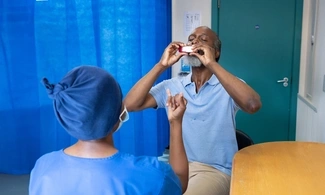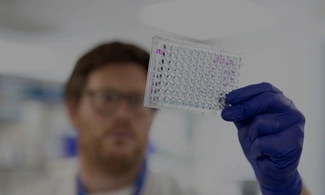Pulmonary vasculitis is a type of inflammation in the blood vessels that affects the lungs. On this page, we have information for parents and carers of children who have been diagnosed with pulmonary vasculitis.
On this page:
- What is pulmonary vasculitis?
- What causes pulmonary vasculitis in children?
- Types of pulmonary vasculitis
- Is my child at risk of pulmonary vasculitis?
- Symptoms of pulmonary vasculitis
- Diagnosing pulmonary vasculitis
- How is pulmonary vasculitis treated?
- Outlook for children with pulmonary vasculitis
- More help and support
What is pulmonary vasculitis?
Pulmonary = to do with the lungs
Vasculitis = inflamed blood vessels
Vasculitis is inflammation (swelling) of the blood vessels. Blood vessels vary in size and carry blood from the heart around the body.
Vasculitis can happen in any blood vessel. There are many different types of vasculitis that affect different parts of the body.
Pulmonary vasculitis is the name given to vasculitis when it affects the lungs.
What causes pulmonary vasculitis in children?
In people with pulmonary vasculitis, the immune system doesn’t work as it should. The body’s white blood cells attack healthy cells instead of bacteria and viruses. This is what causes inflammation in the blood vessels, but we don’t know exactly why this happens.
There is evidence to suggest pulmonary vasculitis is linked with:
- autoimmune disorders – like arthritis or lupus
- infections – such as tuberculosis (TB), Legionnaires’ and Pseudomonas
- drugs – such as penicillin
- diseases – such as Behçet's disease, COPD and asthma
- genetics – some children get pulmonary vasculitis from genes passed on from their biological parents.
Types of pulmonary vasculitis
The types of pulmonary vasculitis that can affect children include:
- Granulomatosis with polyangiitis (GPA) – this used to be called Wegener’s granulomatosis. It can affect the lungs and airways, but can also affect the nose, eyes, ears, and kidneys.
- Eosinophilic granulomatosis with polyangiitis (EGPA) – this used to be called Churg-Strauss syndrome. It most commonly affects the lungs and skin but can also affect blood vessels in other parts of the body. Children with EGPA may have been treated for asthma before EGPA was suspected.
Is my child at risk of pulmonary vasculitis?
Pulmonary vasculitis is very rare. It affects around one in a million children every year.
Symptoms of pulmonary vasculitis
Symptoms of pulmonary vasculitis vary between each child because it can affect different parts of the body.
Symptoms affecting the lungs may include:
- coughing up blood (damaged blood vessels can cause bleeding)
- difficulty breathing
- coughing
- chest pain.
If your child is coughing up blood, or you’re worried about any of their symptoms, seek medical help. Find out about seeing a doctor and when to call 999 about your child’s breathing.
Your child may also have more general symptoms, such as:
- weight loss
- poor appetite
- fever
- tiredness
- a rash - if the vasculitis affects their skin
- blood in their urine - if the vasculitis affects their kidneys.
Your child might be diagnosed with asthma at first, but if they’re not responding to asthma treatment, your doctor may test for pulmonary vasculitis.
Diagnosing pulmonary vasculitis
Your child will have blood tests and a urine test. They may need one or more tests to look at their lungs in more detail:
- an X-ray or CT scan – doctors will look for inflamed blood vessels or areas of bleeding
- bronchoscopy - a narrow, flexible tube with a camera on the end is used to look inside your child’s lungs
- lung biopsy – a surgeon removes some tissue from the lung. This can sometimes be done using keyhole surgery. If doctors think your child’s kidneys might be affected, they may also have a kidney (renal) biopsy.
How is pulmonary vasculitis treated?
Pulmonary vasculitis is a long-term condition with no cure at the moment. It affects each child differently. When your child is diagnosed, they should be treated by specialists.
It’s important to get treatment as soon as possible to prevent or limit long-term damage to the lungs or other organs. Treatment includes:
- steroid therapy – corticosteroids (also known as steroids) will help to reduce the inflammation
- medicine to suppress the immune system – there are many different types of medicine that could be used. Your child’s treatment will depend on how severe their condition is and what might have caused it.
Your child’s specialist will talk to you in detail about the treatment before starting it. They can also make families aware of clinical trials and any new treatments.
Outlook for children with pulmonary vasculitis
Living with pulmonary vasculitis is different for every child and depends on how severe the disease is, and whether any organs are damaged.
Many children respond well to medicines. Others might have more severe disease and will need to take medication long-term.
Ask your child’s doctors who to contact if you have any questions, or if you’re unsure about something. It’s important to be able to recognise if your child’s condition is getting worse, or if they’re becoming ill, and when you should seek emergency care. Agree a plan with your child’s specialist about what you should do.
More help and support
Looking after a child with a long-term condition, like pulmonary vasculitis, can be difficult. It’s important you take time to take care of yourself, as well as your child. Talk to your doctor or nurse if you feel like you’re struggling to cope. You can always call our helpline – our friendly team can help answer your questions or worries. Call 0300 222 5800, Monday to Friday between 9am – 5pm (excluding Bank Holidays).
You may also want to join our Parent and Carer Support Network which provides support and a space for parents and carers of children with lung conditions to come together.
You can also get more information and support on living with vasculitis from Vasculitis UK. They have information for adult and child vasculitis.
This content is currently under review. New information will be available soon.








